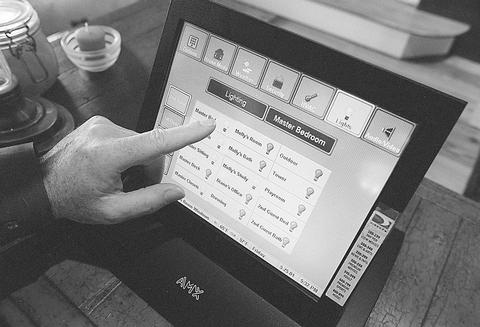Michael McGrath is sitting at the controls in his command center. He's adjusting temperatures, turning out lights, checking for motion in distant rooms, reading the latest weather data.
He's the master of his realm, which includes 10 miles of wiring, nine computers, six phone lines, integrated lighting and security systems, and a weather station.

PHOTO: NY TIMES
You might expect him to be ensconced before a vast console on some futuristic spaceship or scanning the skies at a NASA facility.
Instead, he's sitting in bed in the master suite of his home on the coast of Maine.
His command center is a 15-inch portable touch panel that rests lightly on his lap. This wireless black monitor with its colorful, Las Vegas slot-art windows allows McGrath to control every facet of the state-of-the-art electronic architecture that weaves its way throughout his large house.
On this particular evening, he's taking inventory before retiring for the night. He checks each room to see if there are any doors or windows open and sets the security alarm. He turns on the "goodnight" switch that turns out most of the lights in the multi-level house but dims others to their night setting. He checks the temperature throughout the house, turning it down in the large living areas and making sure it is at the correct setting in his 7-year-old daughter Molly's room and the master suite. He then settles back to listen to music or watch television before he and his wife, Diane, fall asleep.
"When most people move into a new home," said McGrath, founder and chairman of Pittiglio Rabin Todd & McGrath, a management consulting firm in Waltham, Massachusetts, and Integrated Development Enterprise, an application software enterprise in Concord, Massachusetts, "there's always last-minute work being done, usually by painters or floor people. But in our house, the last people to leave were the system programmers who were sitting in the foyer doing last-minute touch-ups on programming."
The McGraths bought their 1.2ha property in 1993 and began building what Michael calls the "house of our dreams" in 1998. It took two years to complete and doubled in size along the way. It now holds a commanding presence on a rocky promontory overlooking the crashing surf below.
Although the actual house was built in less than a year, it took an additional, initial year to blast through the craggy coastal rocks and erect a series of Corinthian granite walls in preparation for laying a foundation for the house.
"We had to blast a lot of rocks," said McGrath, sitting in one of the seating areas in the living room on a recent weekend afternoon. "Some parts of the house are 20m above sea level, other parts are 6m above. Diane wanted a garage that would lead into the kitchen, so we started with the garage and kitchen on the top level and worked from there."
Steel infrastructure
Because the house stands virtually naked before mother nature, great care had to be taken to construct a home that could withstand the fiercest northeaster. To this end, the home's infrastructure is all steel, including steel frames welded around the windows. Extra-heavy shingles were used on the exterior.
"The house wraps along the coast and is one room deep at every point so every room has an ocean view," said McGrath, motioning to the vast panoramic view of the sea seen through a bank of glass windows. "The crescent shape helps to protect much of the house from northeast winds."
Construction involved a core team of the usual suspects, including architect, contractor, and interior designer, plus "anywhere from 50 to 80 people working on the property at one time," said McGrath. Another key player was Media Systems, a Boston company that's been installing state-of-the-art interior electronics for a decade.
"They were with us from the beginning," said McGrath. "They had to be. They were not only going to design all the electronics, but had to work closely with the architect, electricians, carpenters, and cabinet makers."
The success of this collaboration shows -- or rather, doesn't show. All electronic equipment is stacked and stored behind closed, custom-made cabinet doors, all wires and chips are packed behind walls, and ceiling speakers are barely visible, dressed to blend with individual rooms. All a visitor sees are the two small keypads.
"We chose Media Systems because they're the best," said McGrath. The company is run by Mitchell Klein and had revenues of US$5 million last year. "There aren't that many options out there at this point."
Just how many homeowners are interested in installing "smart house" technology? According to a recent survey conducted by Zanthus, an Oregon-based high-technology research consulting firm, 42 percent of US single-family homeowners, or 26.1 million households, are inclined to adopt technology that results in a connected home. These are primarily college-educated homeowners with children between 14 and 18 years old, with an annual household income of US$75,000 to $100,000, and with the breadwinners between the ages of 35 and 54.
Diane McGrath said her husband wanted all the latest electronic equipment to make life more enjoyable.
"He wanted all these new toys," she said.
"But I wanted them to make life easier. He was in it for the fun. I was in it for the more practical reasons." Diane didn't want to have to go to each room to adjust the temperature or the lighting system, nor did she want to operate the security system from only a panel by the front door.
Extra benefits
There were also a few benefits she hadn't thought of but relished.
"I was so pleased when Media Systems suggested I integrate the window Christmas lights into the system," she said. She is a passionate holiday decorator and filled the house with five trimmed trees and dozens of poinsettia plants last winter. "The little red dots on the outlets tell me where to plug in the lights."
Michael wanted music throughout the house, but not just radio and not just one CD option.
Therefore, the house has three CD players allowing classical to be playing upstairs while jazz is playing in the living room and rock in the entertainment room. He wanted a large-screen TV and appropriate speakers so viewers would not only see and hear the movie but feel as if they were in the midst of the action as well.
"He also thought it would be fun to check on the weather," said Diane, "but it's become pretty important in our lives. We access it all the time."
They lost power during a snowstorm in early March, but their generator turned on and they had heat, hot water, and lights.
"We didn't have lights in the entire house, but we had them in the important areas and our appliances worked," said Diane. "The power was out for three days. It's the first time that's happened since we moved in. The generator clicked in just as it was supposed to. Everything worked as planned."
The couple said they use the house "like a neighborhood."
"If we want to go to the movies," said Diane, "we head downstairs to the entertainment center. If we want to go to a bar or play pool, we also head downstairs. Michael has an office here and a library, and there's also an exercise room and sauna."
All of this works as an enticement to bring Michael's three adult children back to Maine for visits.
The main floor consists of a large open living room with two spacious seating areas and a spot for a piano that's integrated into the audio system; a large foyer; a formal dining room; a cozy, paneled library; and immense kitchen with eating area and family room with attached screened porch. There are five fireplaces -- two woodburning, and three gas.
There are three bedrooms and the master suite on the second level. The entertainment room, office, and wine cellar are on the lower level.The house also has an elevator with a phone, and the shaft serves as a main artery for all the wiring as it descends from the upper floors to the electronic heart or control room with its banks of equipment racks.
Although the three touch panels can be carried from room to room, they are most often used in the entertainment room, the kitchen, and the master suite.
"I keep one of the touch panels down here," said Michael, showing off his home video theater with its racks of equipment containing DVD, VCR, cable box, DSS (satellite receivers and all the other electronic components to make up the audio/video system. "We can change the lighting down here depending on what we are watching -- dimmer light for movies, more light for television."
Coded buttons
Lighting buttons are labeled according to activities -- reading, cooking, entertaining, movies, and general illumination.
The security system has fire, gas, and motion detectors. And the communications system includes both internal and external communications. The family can communicate internally by telephone from room to room as well as page the entire house -- dinner's ready -- on the intercom system. There are intercoms in every room.
"We also have hot-water pipes under the floor in two of the bathrooms and the kitchen," said Michael. "So I can come downstairs in barefeet in the morning, walk into the kitchen and hit the touch pad and activate the radiant heat in the floor. We don't have a touch pad to make and pour the coffee," he said with a smile.
The weather station on the roof brings the couple current weather information -- humidity, wind speed and direction, and wind chill -- along with historical data such as how much rain has fallen since March 4.
When the couple goes away on vacation, they hit the vacation button and this replays how the lights were used during the previous week. When they are returning , they can call the house and enter a code that will illuminate the driveway or turn on the radiant heat.
The downsides of all this electronic networking?
"The time it takes to teach a new baby sitter how to turn the lights on and off," said Diane.
"I can spend a lot of time showing them around the house and explaining how to work the lights and the thermostats. Molly becomes almost an afterthought. Oh, by the way, Molly goes to bed at this time."

MORE VISITORS: The Tourism Administration said that it is seeing positive prospects in its efforts to expand the tourism market in North America and Europe Taiwan has been ranked as the cheapest place in the world to travel to this year, based on a list recommended by NerdWallet. The San Francisco-based personal finance company said that Taiwan topped the list of 16 nations it chose for budget travelers because US tourists do not need visas and travelers can easily have a good meal for less than US$10. A bus ride in Taipei costs just under US$0.50, while subway rides start at US$0.60, the firm said, adding that public transportation in Taiwan is easy to navigate. The firm also called Taiwan a “food lover’s paradise,” citing inexpensive breakfast stalls

TRADE: A mandatory declaration of origin for manufactured goods bound for the US is to take effect on May 7 to block China from exploiting Taiwan’s trade channels All products manufactured in Taiwan and exported to the US must include a signed declaration of origin starting on May 7, the Bureau of Foreign Trade announced yesterday. US President Donald Trump on April 2 imposed a 32 percent tariff on imports from Taiwan, but one week later announced a 90-day pause on its implementation. However, a universal 10 percent tariff was immediately applied to most imports from around the world. On April 12, the Trump administration further exempted computers, smartphones and semiconductors from the new tariffs. In response, President William Lai’s (賴清德) administration has introduced a series of countermeasures to support affected

CROSS-STRAIT: The vast majority of Taiwanese support maintaining the ‘status quo,’ while concern is rising about Beijing’s influence operations More than eight out of 10 Taiwanese reject Beijing’s “one country, two systems” framework for cross-strait relations, according to a survey released by the Mainland Affairs Council (MAC) on Thursday. The MAC’s latest quarterly survey found that 84.4 percent of respondents opposed Beijing’s “one country, two systems” formula for handling cross-strait relations — a figure consistent with past polling. Over the past three years, opposition to the framework has remained high, ranging from a low of 83.6 percent in April 2023 to a peak of 89.6 percent in April last year. In the most recent poll, 82.5 percent also rejected China’s

PLUGGING HOLES: The amendments would bring the legislation in line with systems found in other countries such as Japan and the US, Legislator Chen Kuan-ting said Democratic Progressive Party (DPP) Legislator Chen Kuan-ting (陳冠廷) has proposed amending national security legislation amid a spate of espionage cases. Potential gaps in security vetting procedures for personnel with access to sensitive information prompted him to propose the amendments, which would introduce changes to Article 14 of the Classified National Security Information Protection Act (國家機密保護法), Chen said yesterday. The proposal, which aims to enhance interagency vetting procedures and reduce the risk of classified information leaks, would establish a comprehensive security clearance system in Taiwan, he said. The amendment would require character and loyalty checks for civil servants and intelligence personnel prior to